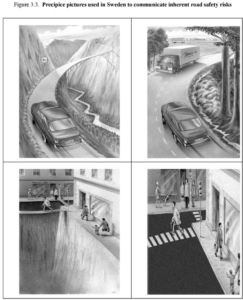
Perhaps more than ever in US history, Sweden is entering the public eye. It’s not in the context of IKEA or The Cardigans, but in how they manage their roads and the people who use them. To put it directly, people in the US are paying more attention to car seat safety and car safety overall in Sweden than ever before. This isn’t news on the CCD; I’ve written endlessly about this topic, such as when comparing European roads to US roads, calculating the differences between Swedish and US annual mileages, describing Volvo’s Vision Zero plans, advocating rear-facing past 2 as in Sweden, reviewing Swedish car seat safety vs US ones, sharing why you can’t buy Swedish car seats in the US, explaining Swedish car seat policies, contrasting Swedish booster practices to ours, or when deconstructing Swedish rear-facing myths. The good news is that more people are taking an interest in how Swedes practice road safety; the bad news is that there are still a lot of misconceptions spread by well-intentioned individuals, especially when writing from a US-centric perspective. Let’s break down a recent article to piece together what’s accurate and what’s not when explaining the differences between Swedish roads and those in the US. This is the first of a 3 part series examining misunderstandings in the American public discourse on best practices in Sweden.
Extended rear-facing in Sweden didn’t begin in 2011, as it largely did in the US
In 2011, the American Academy of Pediatrics (A.A.P.) released a policy statement on car safety that recommended that children ride in rear-facing car seats until at least age 2. Before that, the recommendation was until 1. This change caused something of an internet firestorm.

Right off the bat, the author, an American pediatrics professor, makes the assumption that the American Academy of Pediatrics’ recommendation to rear-face until 2 in 2011 was revolutionary. The truth is that it wasn’t. The Swedes had already been rear-facing until 2 for at least 30 years (i.e., since the 1980s), and had largely been rear-facing until 4 for almost as long. This wasn’t because of any legal pressure; you won’t get arrested for forward-facing a 2 year old in Sweden. It was because of effective collaboration between the government and the media to publicize the immeasurable safety benefits of extended rear-facing. In Sweden, citizens had grown used to a culture of safety decades in the making, and a more trusting population paired with a more trustworthy government made the transition to extended rear-facing a relatively smooth one over the years. The only “firestorm” about continuing to rear-face past 1 (which is where the AAP set their recommendation in 2002) occurred among parents who were still fighting the even-worse recommendation to rear-face babies. And as I note in the link above, the AAP’s recommendation to rear-face until 2 was already decades behind best practices the day it was released.
A culture of abdication of parental authority begets poor parental decisions
It’s not terribly hard to get small babies into an American-style rear-facing car seat, but those who are nearly 2 years old are a different story. They often resist. They can fight. It can be miserable for both parties.

It’s disappointing, yet not unexpected, to read a professional, an influencer in the sphere of parental attitudes and child-rearing practices, cede so much parental authority so quickly. Toddlers in the US aren’t genetically different from toddlers in Sweden, in Somalia, or anywhere else in the world. They all say “no” in whatever language they’re taught (or languages, since most children on Earth are multilingual), they all throw tantrums, and they’re all incapable of making decisions about car safety. The fact that a 2 year old does or doesn’t want to sit rear-facing is completely, utterly irrelevant. The only thing that matters when transporting a child in a vehicle is keeping that child safe. We don’t let toddlers play in the street, run with scissors, or shoot guns (well, that one’s kind of iffy in the US) simply because they “resist” or “fight” or make us “miserable.” We parent. If you rear-face a toddler, your toddler will rear-face. If you let your toddler tell you what to do, you might as well stop using seat belts altogether. Otherwise, get a Clek Fllo, a Clek Foonf, or a Diono Rainier and rear-face your child as long as s/he fits, just as a Swede would.
There is no debate in the reality-based community about the benefits of rear-facing
The researchers concluded, “Field data are too limited to serve as a strong statistical basis for these recommendations.”
This has left people once again debating whether parents in the United States need to keep wrestling children into rear-facing car seats all the way until age 2.

I covered this “issue” in an article analyzing car seat safety recommendations directly from the Swedish equivalent of the NTSB, but to summarize the above link, there is no debate here. The people debating whether or not rear-facing is safer than forward-facing are brethren of the people who debate whether or not climate change exists, whether vaccines cause Autism, and whether 9/11 and the moon landings were faked. If you search for nonsense on the Internet, you will undoubtedly find it, and enough of it to keep you entertained for the rest of your days. But in the mean time, the American profit-driven back-and-forth research “culture” that relies on microstudies that can give 10 different answers when run with 10 different populations or statistical tests isn’t where you want to get your best practices.
It’s generally a better idea (whether in car seat safety, in car safety, or in any other issues involving public and personal health) to take advice from countries that don’t have such an incestuous blend of governments and corporations driving public opinions and policies. To put it bluntly, the US is the only country on Earth where a lot of things taken as givens in other parts of the world are still up for debate (e.g., whether or not our gun policies are insane). If you want to live a safer, saner, healthier life, you need to look beyond our borders for advice or be very selective about the advice you follow within them.
Stay tuned for part 2, where we’ll look at the author’s assertion of whether car seats in Sweden are all that different from those in the US. In case you’d like a spoiler, they’re not.
 If you find my information on best practices in car and car seat safety helpful, you can buy my books here or do your shopping through this Amazon link. Canadians can shop here for Canadian purchases. Have a question or want to discuss best practices? Send me an email at carcrashdetective [at] gmail [dot] com.
If you find my information on best practices in car and car seat safety helpful, you can buy my books here or do your shopping through this Amazon link. Canadians can shop here for Canadian purchases. Have a question or want to discuss best practices? Send me an email at carcrashdetective [at] gmail [dot] com.

